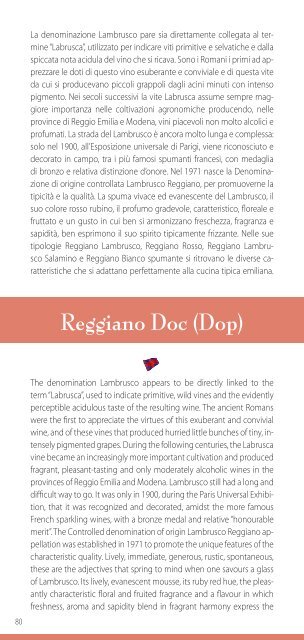Terre di Lambrusco_2013_WEB.pdf
Terre di Lambrusco_2013_WEB.pdf
Terre di Lambrusco_2013_WEB.pdf
Create successful ePaper yourself
Turn your PDF publications into a flip-book with our unique Google optimized e-Paper software.
La denominazione <strong>Lambrusco</strong> pare sia <strong>di</strong>rettamente collegata al termine“Labrusca”, utilizzato per in<strong>di</strong>care viti primitive e selvatiche e dallaspiccata nota acidula del vino che si ricava. Sono i Romani i primi ad apprezzarele doti <strong>di</strong> questo vino esuberante e conviviale e <strong>di</strong> questa viteda cui si producevano piccoli grappoli dagli acini minuti con intensopigmento. Nei secoli successivi la vite Labrusca assume sempre maggioreimportanza nelle coltivazioni agronomiche producendo, nelleprovince <strong>di</strong> Reggio Emilia e Modena, vini piacevoli non molto alcolici eprofumati. La strada del <strong>Lambrusco</strong> è ancora molto lunga e complessa:solo nel 1900, all’Esposizione universale <strong>di</strong> Parigi, viene riconosciuto edecorato in campo, tra i più famosi spumanti francesi, con medaglia<strong>di</strong> bronzo e relativa <strong>di</strong>stinzione d’onore. Nel 1971 nasce la Denominazione<strong>di</strong> origine controllata <strong>Lambrusco</strong> Reggiano, per promuoverne latipicità e la qualità. La spuma vivace ed evanescente del <strong>Lambrusco</strong>, ilsuo colore rosso rubino, il profumo gradevole, caratteristico, floreale efruttato e un gusto in cui ben si armonizzano freschezza, fragranza esapi<strong>di</strong>tà, ben esprimono il suo spirito tipicamente frizzante. Nelle suetipologie Reggiano <strong>Lambrusco</strong>, Reggiano Rosso, Reggiano <strong>Lambrusco</strong>Salamino e Reggiano Bianco spumante si ritrovano le <strong>di</strong>verse caratteristicheche si adattano perfettamente alla cucina tipica emiliana.Reggiano Doc (Dop)The denomination <strong>Lambrusco</strong> appears to be <strong>di</strong>rectly linked to theterm “Labrusca”, used to in<strong>di</strong>cate primitive, wild vines and the evidentlyperceptible acidulous taste of the resulting wine. The ancient Romanswere the first to appreciate the virtues of this exuberant and convivialwine, and of these vines that produced hurried little bunches of tiny, intenselypigmented grapes. During the following centuries, the Labruscavine became an increasingly more important cultivation and producedfragrant, pleasant-tasting and only moderately alcoholic wines in theprovinces of Reggio Emilia and Modena. <strong>Lambrusco</strong> still had a long and<strong>di</strong>fficult way to go. It was only in 1900, during the Paris Universal Exhibition,that it was recognized and decorated, amidst the more famousFrench sparkling wines, with a bronze medal and relative “honourablemerit”. The Controlled denomination of origin <strong>Lambrusco</strong> Reggiano appellationwas established in 1971 to promote the unique features of thecharacteristic quality. Lively, imme<strong>di</strong>ate, generous, rustic, spontaneous,these are the adjectives that spring to mind when one savours a glassof <strong>Lambrusco</strong>. Its lively, evanescent mousse, its ruby red hue, the pleasantlycharacteristic floral and fruited fragrance and a flavour in whichfreshness, aroma and sapi<strong>di</strong>ty blend in fragrant harmony express the80



